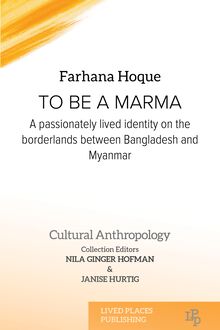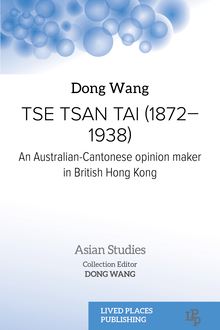-
 Univers
Univers
-
 Ebooks
Ebooks
-
 Livres audio
Livres audio
-
 Presse
Presse
-
 Podcasts
Podcasts
-
 BD
BD
-
 Documents
Documents
-
- Cours
- Révisions
- Ressources pédagogiques
- Sciences de l’éducation
- Manuels scolaires
- Langues
- Travaux de classe
- Annales de BEP
- Etudes supérieures
- Maternelle et primaire
- Fiches de lecture
- Orientation scolaire
- Méthodologie
- Corrigés de devoir
- Annales d’examens et concours
- Annales du bac
- Annales du brevet
- Rapports de stage
La lecture à portée de main
Vous pourrez modifier la taille du texte de cet ouvrage
Découvre YouScribe en t'inscrivant gratuitement
Je m'inscrisDécouvre YouScribe en t'inscrivant gratuitement
Je m'inscrisEn savoir plus
Vous pourrez modifier la taille du texte de cet ouvrage
En savoir plus

Description
How does being located in borderlands impact cultural identity, through both assimilation and distinctness?
This exploration of the self-identified Marma group, the second largest ethnic group in the Chittagong Hill Tracts (CHT) of Bangladesh, discusses various aspects of identity creation, maintenance and adaptation in the unique setting of the geo-political border between South and Southeast Asia. With the fluidity of change and ethnic composition that is typical of geographical borders, the expectation is constant adaptation resulting in slow change of cultural identity over time. In the Marma case, adaptations are made in order to maintain their cultural distinctiveness. Drawing from stories of the people who hold this identity, the book considers how cultural groups navigate the constant demands on their identity whilst living in borderlands.
Introduction
Chapter 1: Teacher and student guide
Learning objective
Learner objectives
Suggested activities (general)
Suggested activities (by chapter)
Recommended projects
Chapter 2: The project and the people
Chapter 3: A toolkit to study identity on the borderlands: A brief summary
Chapter 4: Marma kinship and marriage rituals
Chapter 5: Ethnic endogamy: land, culture and religion
Chapter 6: Migration and settlement
Chapter 7: The invention of Marma material culture and ceremonials
Chapter 8: Conclusions
Sujets
Informations
| Publié par | Lived Places Publishing |
| Date de parution | 22 août 2022 |
| Nombre de lectures | 1 |
| EAN13 | 9781915271198 |
| Langue | English |
| Poids de l'ouvrage | 1 Mo |
Informations légales : prix de location à la page 0,1250€. Cette information est donnée uniquement à titre indicatif conformément à la législation en vigueur.
Extrait
To be a Marma
Farhana Hoque
To be a Marma
The Anthropology Collection
Editor
Janise Hurtig
First published in 2022 by Lived Places Publishing
All rights reserved. No part of this publication may be reproduced, stored in a retrieval system, or transmitted in any form or by any means, electronic, mechanical, photocopying, recording or otherwise, without prior permission in writing from the publisher.
The author and editors have made every effort to ensure the accuracy of information contained in this publication, but assume no responsibility for any errors, inaccuracies, inconsistencies and omissions. Likewise, every effort has been made to contact copyright holders. If any copyright material has been reproduced unwittingly and without permission the Publisher will gladly receive information enabling them to rectify any error or omission in subsequent editions.
Copyright © 2022 Lived Places Publishing
British Library Cataloguing in Publication Data
A CIP record for this book is available from the British Library
ISBN: 9781915271181 (pbk)
ISBN: 9781915271204 (ePDF)
ISBN: 9781915271198 (ePUB)
The right of Farhana Hoque to be identified as the Author of this work has been asserted by her in accordance with the Copyright, Design and Patents Act 1988.
Cover design by Fiachra McCarthy
Book design by Rachel Trolove of Twin Trail Design
Typeset by Newgen Publishing UK
Lived Places Publishing
Long Island
New York 11789
www.livedplacespublishing.com
For Sami and Hana
Abstract
The book explores a passionately lived identity on the borderlands between South and Southeast Asia. It focusses on one ethnic group, the Marma of the Chittagong Hill Tracts. The book places the everyday lives and meanings of a remote hill people at the heart of a study on identity and nothing is taken for granted. By looking at the history of the region and the way it has shaped the Marma, as well as an analysis of ethnographic data, the book establishes the nature of the group’s cultural distinctness. Themes covered are Marma marriage customs and rituals, oral histories around migration and settlement, and Marma material culture and ceremonials.
Keywords
Marma; Chittagong Hill Tracts; Bangladesh; Buddhism; Burma/Myanmar; ethnic identity; invention of culture; hybridity; syncretism; entanglement; borderlands; migration; Zomia
Contents
Acknowledgements ix
Introduction 1
Chapter 1 Teacher and student guide 15
Learning objectives 15
Learner objectives 15
Suggested activities (general) 16
Suggested activities (by chapter) 16
Recommended projects 17
Chapter 2 The project and the people 19
Chapter 3 A toolkit to study identity on the borderlands: a brief summary 35
Chapter 4 Marma kinship and marriage rituals 43
Chapter 5 Ethnic endogamy: land, culture, and religion 79
Chapter 6 Migration and settlement 101
Chapter 7 The invention of Marma material culture and ceremonials 137
Conclusions 163
Notes 172
References 189
Recommended further reading 197
Glossary 200
Appendix A Introductions and experts in the Marma community 210
Appendix B Historical timeline 214
Appendix C A toolkit to study identity on the borderlands 216
Appendix D Royal chart and new genogram 244
Appendix E Map of Bandarban with shrines 246
Appendix F Documentary – To be a Marma 249
Index 251
Acknowledgements
The ethnographic research was initially made possible thanks to the help of Professor Willem Van Schendel, who is an expert on Asian borderlands . My special thanks go to Shai Shing Aung, his family – including his monk grandfather – and his musical circle of friends for incorporating me into the spiritual and joyful rhythms of their lives. I am extremely grateful for getting to know Daisy, Lobu, and Dauki, and that we became good friends. And to Jerry Allen – honorary Khyang by marriage – for sharing his photos from the raj punya of the 15th Bohmong .
My gratitude to my Bangladeshi aunts and cousins in Dhaka and Chittagong for stopovers, meals, and laughter. And to my mother – Amina Chowdhury – who accompanied me on the first trip, navigating a very challenging country that was different to the country she left behind in 1971. To Fiona Kerlogue (Horniman Museum) and Ed Owles (Postcode Films) for the exciting projects around material culture and film that helped to make the Marma narrative take on another life beyond the written word.
Back home in London, I am indebted to my supervisors at University College London – Dr Allen Abramson and Professor Roland Littlewood – for their invaluable guidance, energy, and support during the long journey of completing my PhD, on which this book is based.
Introduction
In the last 30 years, borderlands all over the world have been part of the political and academic debates around globalisation , migration , and security. In Europe, for example, the expansion of the European Union, the collapse of the Soviet bloc, the shaping of new nations, and the mass movement of peoples from east to west and south to north are but some of the factors that have not only transformed borders in Europe but also stimulated new kinds of scholarship around it.
Anthropologists have been part of these debates, but specifically looking at the cultural effects of globalisation and migration on border communities. Some border studies also try to understand how ethnic groups negotiate their identity alongside other cultures that express similar or different notions of being and belonging on the borderlands .
This book is a contribution to border studies and identity. It focuses on a region called the Chittagong Hill Tracts (CHT), which straddles the borders between Bangladesh and Myanmar. This region has experienced many different groups migrating to the area and has been governed over a period of approximately 500 years by an impressive line-up of local and global powers – the Arakan kingdom , the Portuguese , the Mughals, and the British Empire . This book is an exploration of the identity of one ethnic group – the Marma – who live in this historically complex and fluid region of the world.
The stories and thoughts you will find in this book are based on the fieldwork in the Marma community that was part of my PhD research at University College London. This fieldwork was conducted between November 2012 and December 2014, in Bandarban town in the CHT.
Meet the Marma
I was born in Bangladesh, or East Pakistan as it was then, and my family left the region towards the end of Bangladesh’s War of Independence in 1971. 1 In 2012, I returned to the CHT in Bangladesh for the first time in 20 years to begin the fieldwork.
On a previous visit to the CHT in 1993, I had travelled the country on holiday as a young adult and met for the first time the Chakma people in and around Rangamati in the CHT. The area was off-limits to foreigners, but as a Bangladesh-born citizen I was able to travel the area unhindered. What struck me then was the contrast with “mainland” Bangladesh, with its expansive, flat delta and densely populated towns and cities. The CHT, in sharp contrast, was sparsely populated. There were at the time 15 ethnic groups living in small rural towns and villages scattered across this hilly jungle landscape. Moreover, the people in the hill tracts looked, dressed, and acted differently to the Bangladeshis that I had encountered.
Returning in 2012, the contrast was, if anything, even greater. Departing from Chittagong, by then the second-largest city in Bangladesh with a population of circa 4 million, I travelled to Bandarban town in the CHT, which had a population of approximately 32,000. In and around Bandarban town, alongside the numerous mosques calling Bengali Muslims to prayer, stood several Arakan-style 2 royal palaces built by various Bohmong Rajas – chiefs or kings of the Marma people – and an impressive Golden Buddhist temple. My first impressions of Bandarban were not that different from a description of the community noted in 1927:
To one who has become used to the Bengali atmosphere of the Chakma and Mong circles, to visit Bandarban , the headquarters of the Bohmong , is to enter a new world. It is pure Burma, with yellow-robed priests, Bhuddhist temples and a populace clad in Burmese dress of all the colours of the rainbow. There Bengali culture is disdained as something alien, and all regard Burma as their spiritual home. This clear-cut and striking difference between the Bohmong’s circle and those of the Chakma Chief and the Mong Raja cannot be too strongly emphasized.
( Mills, 1927 , p. 75)
When staying with a Marma family in a compound of five households, I experienced even more interesting juxtapositions. This Marma family spoke fluent Bengali 3 to non-Marma visitors, so it seemed that Bengali had become the lingua franca of the region. They spoke Marma to each other, a language that has a written script which mostly the elder members of the family know how to read. The family loosely followed Bengali eating customs and mealtimes, but the content of the food was very different to a typical Bengali meal: fried strips of wild boar, river oysters, bamboo shoots, and many soupy cabbage dishes. There was a photo of the prime minister of Bangladesh – Sheikh Hasina 4 – in their communal rooms. However, tucked away in the most private rooms of their homes was a family Buddhist shrine.
The Marma dress style was Burmese in origin and the envy of the other ethnic groups of the CHT, who seem to have either adopted Bengali clothes – a sari or shalwar kameez – or tribal renditions of Bengali-style clothing. I came to learn that Marma practise ethnic endogamy: a custom of marrying within the limits of the clan or ethnic group. Intermarriage with tribal groups, if they were Buddhist, was tolerated. However, a Muslim marriage partner was frowned upon. I was also informed of the most recent scandal in the royal family: the daughter of the Bohmong Raja (King) had married a local Banglade
-
 Univers
Univers
-
 Ebooks
Ebooks
-
 Livres audio
Livres audio
-
 Presse
Presse
-
 Podcasts
Podcasts
-
 BD
BD
-
 Documents
Documents
-
Jeunesse
-
Littérature
-
Ressources professionnelles
-
Santé et bien-être
-
Savoirs
-
Education
-
Loisirs et hobbies
-
Art, musique et cinéma
-
Actualité et débat de société
-
Jeunesse
-
Littérature
-
Ressources professionnelles
-
Santé et bien-être
-
Savoirs
-
Education
-
Loisirs et hobbies
-
Art, musique et cinéma
-
Actualité et débat de société
-
Actualités
-
Lifestyle
-
Presse jeunesse
-
Presse professionnelle
-
Pratique
-
Presse sportive
-
Presse internationale
-
Culture & Médias
-
Action et Aventures
-
Science-fiction et Fantasy
-
Société
-
Jeunesse
-
Littérature
-
Ressources professionnelles
-
Santé et bien-être
-
Savoirs
-
Education
-
Loisirs et hobbies
-
Art, musique et cinéma
-
Actualité et débat de société
- Cours
- Révisions
- Ressources pédagogiques
- Sciences de l’éducation
- Manuels scolaires
- Langues
- Travaux de classe
- Annales de BEP
- Etudes supérieures
- Maternelle et primaire
- Fiches de lecture
- Orientation scolaire
- Méthodologie
- Corrigés de devoir
- Annales d’examens et concours
- Annales du bac
- Annales du brevet
- Rapports de stage








